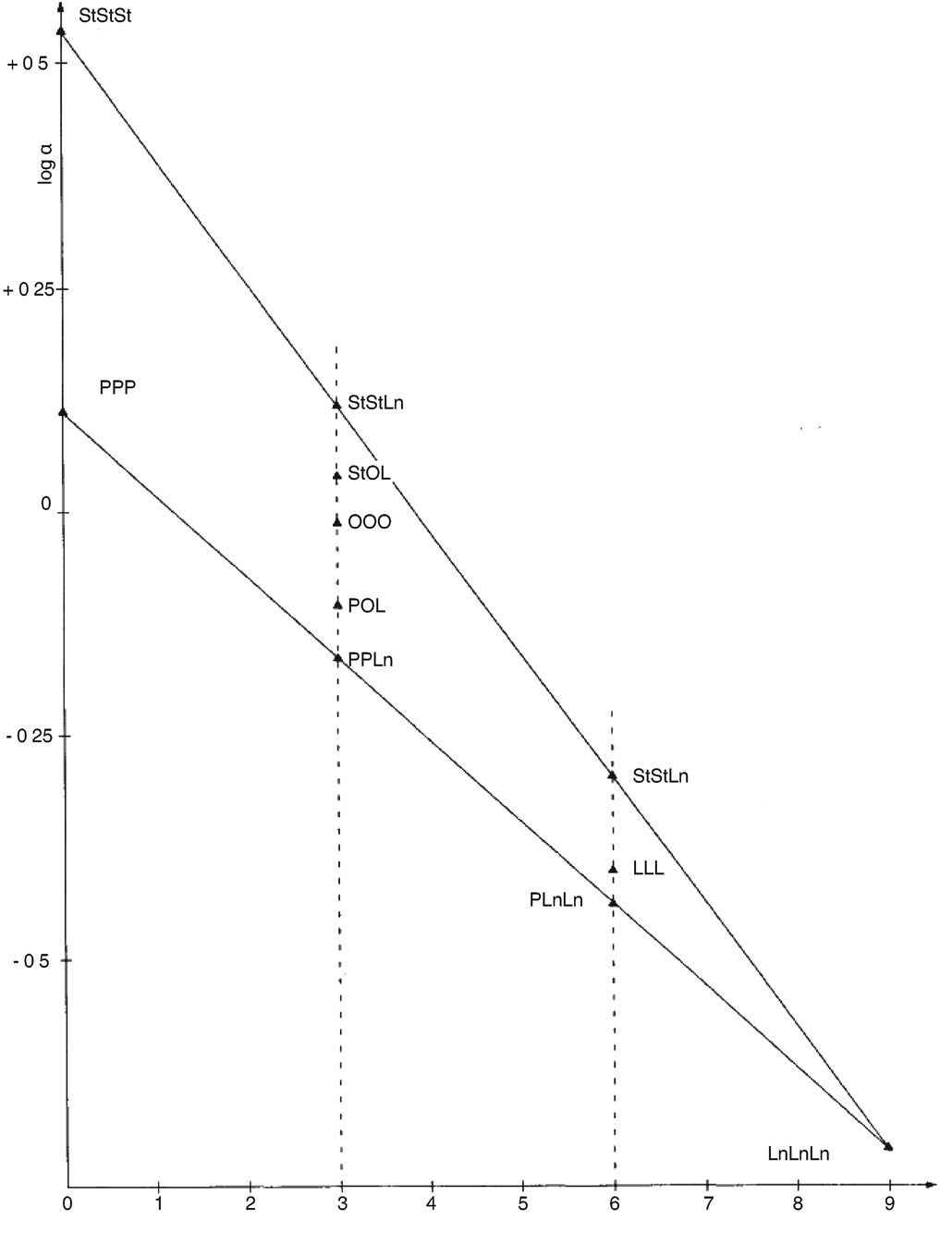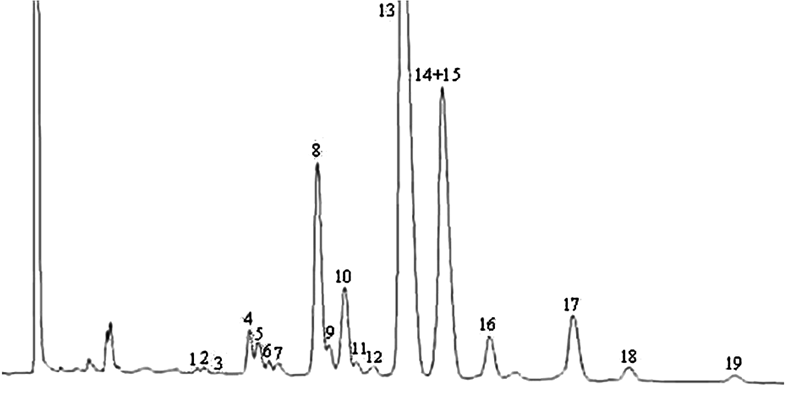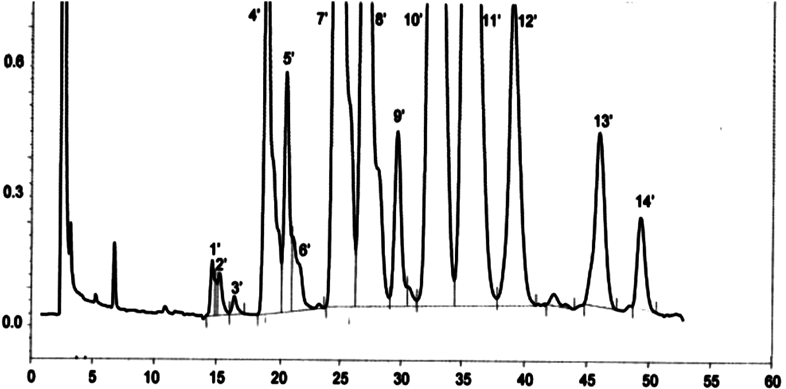ANNEX IIU.K.
“ANNEX XVIII DETERMINATION OF THE DIFFERENCE BETWEEN ACTUAL AND THEORETICAL CONTENT OF TRIACYLGLYCEROLS WITH ECN 42
1.SCOPEU.K.
Determination of the absolute difference between the experimental values of triacylglycerols (TAGs) with equivalent carbon number 42 (ECN42HPLC) obtained by determination in the oil by high performance liquid chromatography and the theoretical value of TAGs with an equivalent carbon number of 42 (ECN 42theoretical) calculated from the fatty acid composition.
2.FIELD OF APPLICATIONU.K.
The standard is applicable to olive oils. The method is applicable to the detection of the presence of small amounts of seed oils (rich in linoleic acid) in every class of olive oils.
3.PRINCIPLEU.K.
The content of triacylglycerols with ECN 42 determined by HPLC analysis and the theoretical content of triacylglycerols with ECN 42 (calculated on the basis of GLC determination of fatty acid composition) correspond within a certain limit for genuine olive oils. A difference larger than the values adopted for each type of oil points out that the oil contains seed oils.
4.METHODU.K.
The method for the calculation of the theoretical content of triacylglycerols with ECN 42 and of the difference with respect to the HPLC data is essentially made by the coordination of analytical data obtained by means of other methods. It is possible to distinguish three phases: determination of fatty acid composition by capillary gas chromatography, calculation of theoretical composition of triacylglycerols with ECN 42, HPLC determination of ECN 42 triacylglycerols.
4.1. Apparatus U.K.
4.1.1.Round-bottomed flasks, 250 and 500 ml.U.K.
4.1.2.Beakers 100 ml.U.K.
4.1.3.Glass chromatographic column, 21 mm internal diameter, 450 mm length, with cock and normalised cone (female) at the top.U.K.
4.1.4.Separating funnels, 250 ml, with normalised cone (male) at the bottom, suitable for connection to the top of the column.U.K.
4.1.5.Glass rod, 600 mm length.U.K.
4.1.6.Glass funnel, 80 mm diameter.U.K.
4.1.7.Volumetric flasks, 50 ml.U.K.
4.1.8.Volumetric flasks, 20 ml.U.K.
4.1.9.Rotary evaporator.U.K.
4.1.10.High performance liquid chromatograph, allowing thermostatic control of column temperature.U.K.
4.1.11.Injection units for 10 μl delivery.U.K.
4.1.12.Detector: differential refractometer. The full scale sensitivity should be at least 10–4 units of refractive index.U.K.
4.1.13.Column: stainless steel tube 250 mm length x 4,5 mm internal diameter packed with 5 μm diameter particles of silica with 22 to 23 % carbon in the form of octadecylsilane.U.K.
4.1.14.Data processing software.U.K.
4.1.15.Vials, of about 2 ml volumes, with Teflon-layered septa and screw caps.U.K.
4.2. Reagents U.K.
The reagents should be of analytical purity. Elution solvents should be de-gassed, and may be recycled several times without effect on the separations.
4.2.1.Petroleum ether 40– 60 °C chromatographic grade or hexane.U.K.
4.2.2.Ethyl ether, peroxide-free, freshly distilled.U.K.
4.2.3.Elution solvent for purifying the oil by column chromatography mixture petroleum ether/ethyl ether 87/13 (v/v).U.K.
4.2.4.Silica gel, 70-230 mesh, type Merck 7734, with water content standardised at 5 % (w/w/).U.K.
4.2.5.Glass wool.U.K.
4.2.6.Acetone for HPLC.U.K.
4.2.7.Acetonitrile or propionitrile for HPLC.U.K.
4.2.8.HPLC elution solvent: acetonitrile + acetone (proportions to be adjusted to obtain the desired separation; begin with 50:50 mixture) or propionitrile.U.K.
4.2.9.Solubilisation solvent: acetone.U.K.
4.2.10.Reference triglycerides: commercial triglycerides (tripalmitin, triolein, etc.) may be used and the retention times then plotted in accordance with the equivalent carbon number, or alternatively reference chromatograms obtained from soya oil, mixture 30:70 soya oil — olive oil and pure olive oil (see notes 1 and 2 and figures 1 to 4).U.K.
4.2.11.Solid phase extraction column with silica phase 1 g, 6 ml.U.K.
4.3. Sample preparation U.K.
As a number of interfering substances can give rise to false positive results, the sample must always be purified according to IUPAC method 2.507, used for the determination of polar compounds in frying fats.
4.3.1. Chromatographic column preparation U.K.
Fill the column (4.1.3) with about 30 ml of elution solvent (4.2.3), then introduce inside the column some glass wool (4.2.5) pushing it to the bottom of the column by means of the glass rod (4.1.5).
In a 100 ml beaker, suspend 25 g of silica gel (4.2.4) in 80 ml of elution mixture (4.2.3), then transfer it to the column by means of a glass funnel (4.1.6).
To ensure the complete transfer of the silica gel to the column, wash the beaker with the elution mixture and transfer the washing portions to the column too.
Open the cock and let the solvent elute from the column until its level is about 1 cm over the silica gel.
4.3.2. Column chromatography U.K.
Weigh with the accuracy of 0,001 g, 2,5 ± 0,1 g of oil, previously filtered, homogenised and anhydrified, if necessary, in a 50 ml volumetric flask (4.1.7).
Dissolve it in about 20 ml of elution solvent (4.2.3). If necessary, slightly heat it to make the dissolution easily. Cool at room temperature and adjust the volume with elution solvent.
By means of a volumetric pipette, introduce 20 ml of solution inside the column prepared according to 4.3.1, open the cock and let the solvent elute to the silica gel layer level.
Then elute with 150 ml of elution solvent (4.2.3), adjusting the solvent rate at about 2 ml/min (150 ml will take about 60-70 minutes to pass through the column).
The eluate is recovered in a 250 ml round-bottomed flask (4.1.1) previously tared in an oven and exactly weighed. Eliminate the solvent at reduced pressure in a rotary evaporator (4.1.9) and weigh the residue that will be used to prepare the solution for HPLC analysis and for methyl ester preparation.
The sample recovery from the column must be 90 % at least for the extra virgin, virgin, ordinary, refined and olive oil categories, and a minimum of 80 % for lampante and olive-pomace oils.
4.3.3. SPE purification U.K.
Silica SPE column is activated by passing 6 ml of hexane (4.2.3) under vacuum, avoiding dryness.
Weigh to an accuracy of 0,001 g, 0,12 g in a 2 ml vial (4.1.15) and dissolve with 0,5 ml of hexane (4.2.3).
Load the SPE column with the solution and elute with 10 ml of hexane-diethyl ether (87:13 v/v) (4.2.3) under vacuum.
The collected fraction is evaporated to dryness in a rotary evaporator (4.1.9) under reduced pressure at room temperature. The residue is dissolved in 2 ml of acetone (4.2.6) for triacylglycerol (TAG) analysis.
4.4. HPLC analysis U.K.
4.4.1. Preparation of the samples for chromatographic analysis U.K.
A 5 % solution of the sample to be analysed is prepared by weighing 0,5 ± 0,001 g of the sample into a 10 ml graduated flask and making up to 10 ml with the solubilisation solvent (4.2.9).
4.4.2. Procedure U.K.
Set up the chromatographic system. Pump elution solvent (4.2.8) at a rate of 1,5 ml/min to purge the entire system. Wait until a stable base line is obtained.
Inject 10 μl of the sample prepared as in point 4.3.
4.4.3. Calculation and expression of results U.K.
Use the area normalisation method, i.e. assume that the sum of the areas of the peaks corresponding to TAGs from ECN 42 up to ECN 52 is equal to 100 %.
Calculate the relative percentage of each triglyceride using the formula:
The results should be given to at least two decimal places.
See notes 1 to 4.
4.5. Calculation of triacylglycerols composition (moles %) from fatty acid composition data (area %) U.K.
4.5.1. Determination of fatty acid composition U.K.
Fatty acid composition is determined by ISO 5508 by means of a capillary column. The methyl esters are prepared according to COI/T.20/Doc. No 24.
4.5.2. Fatty acids for calculation U.K.
Glycerides are grouped by their Equivalent Carbon Number (ECN), taking into account the following equivalencies between ECN and fatty acids. Only fatty acids with 16 and 18 carbon atoms were taken into consideration, because only these are important for olive oil. The fatty acids should be normalised to 100 %.
| Fatty acid (FA) | Abbreviation | Molecular weight(MW) | ECN |
|---|---|---|---|
| Palmitic acid | P | 256,4 | 16 |
| Palmitoleic acid | Po | 254,4 | 14 |
| Stearic acid | S | 284,5 | 18 |
| Oleic acid | O | 282,5 | 16 |
| Linoleic acid | L | 280,4 | 14 |
| Linolenic acid | Ln | 278,4 | 12 |
4.5.3. Conversion of area % into moles for all fatty acids (1) U.K.
4.5.4. Normalisation of fatty acid moles to 100 % (2) U.K.
The result gives the percentage of each fatty acid in moles % in the overall (1, 2, 3–) position of the TAGs.
Then the sum of the saturated fatty acids P and S (SFA) and the unsaturated fatty acids Po, O, L and Ln (UFA) are calculated (3):
4.5.5. Calculation of the fatty acid composition in 2- and 1, 3- positions of TAGs U.K.
The fatty acids are distributed to three pools as follows: one for 2- position and two identical for 1- and 3- positions, with different coefficients for the saturated (P and S) and unsaturated acids (Po, O, L and Ln).
4.5.5.1.Saturated fatty acids in 2-position [P(2) and S(2)] (4):U.K.
4.5.5.2.Unsaturated fatty acids in 2-position [Po(2), O(2), L(2) and Ln(2)] (5):U.K.
4.5.5.3.Fatty acids in 1,3-positions [P(1,3), S(1,3), Po(1,3), O(1,3), L(1,3) and Ln(1,3)] (6):U.K.
4.5.6. Calculation of triacylglycerols U.K.
4.5.6.1.TAGs with one fatty acid (AAA, here LLL, PoPoPo) (7)U.K.
4.5.6.2.TAGs with two fatty acids (AAB, here PoPoL, PoLL) (8)U.K.
4.5.6.3.TAGs with three different fatty acids (ABC, here OLLn, PLLn, PoOLn, PPoLn) (9)U.K.
4.5.6.4.Triacylglycerols with ECN42U.K.
The triacylglycerols with ECN42 are calculated according to equations 7, 8 and 9 and are then given in order of expected elution in HPLC (normally only three peaks).
LLL
PoLL and the positional isomer LPoL
OLLn and the positional isomers OLnL and LnOL
PoPoL and the positional isomer PoLPo
PoOLn and the positional isomers OPoLn and OLnPo
PLLn and the positional isomers LLnP and LnPL
PoPoPo
SLnLn and the positional isomer LnSLn
PPoLn and the positional isomers PLnPo and PoPLn
The triacylglycerols with ECN42 are given by the sum of the nine triacylglycerols including their positional isomers. The results should be given to at least two decimal places.
5.EVALUATION OF THE RESULTSU.K.
The calculated theoretical content and the content determined by the HPLC analysis are compared. If the difference in the absolute value of the HPLC data minus the theoretical data is greater than the values stated for the appropriate oil category in the standard, the sample contains seed oil.
Results are given to two decimal figures.
6.EXAMPLE (THE NUMBERS REFER TO THE SECTIONS IN THE TEXT OF THE METHOD)U.K.
— 4.5.1. Calculation of moles % fatty acids from GLC data (normalised area %) U.K.
The following data are obtained for the fatty acid composition by GLC:
| FA | P | S | Po | O | L | Ln |
|---|---|---|---|---|---|---|
| MW | 256,4 | 284,5 | 254,4 | 282,5 | 280,4 | 278,4 |
| Area % | 10,0 | 3,0 | 1,0 | 75,0 | 10,0 | 1,0 |
— 4.5.3 Conversion of area % into moles for all fatty acids (see formula (1)) U.K.
=
0,35821 moles TAGs
— 4.5.4 Normalisation of fatty acid moles to 100 % (see formula (2)) U.K.
=
100 %
Sum of the saturated and unsaturated fatty acids in the 1,2,3-position of TAGs (see formula (3)):
— 4.5.5 Calculation of the fatty acid composition in 2- and 1,3-positions of the TAGs U.K.
— 4.5.5.1Saturated fatty acids in 2-position [P(2) and S(2)] (see formula (4))U.K.
— 4.5.5.2Unsaturated fatty acids in 2-position [Po(1,3), O(1,3), L(1,3) and Ln(1,3)] (see formula (5))U.K.
— 4.5.5.3Fatty acids in 1,3-positions [P(1,3), S(1,3), Po(1,3), O(1,3), L(1,3) and Ln(1,3)] (see formula (6))U.K.
— 4.5.6. Calculation of triacylglycerols U.K.
From the calculated fatty acid composition in sn-2- and sn-1,3-positions:
| FA in | 1,3-pos | 2-pos |
|---|---|---|
| P | 16,004 % | 0,653 % |
| S | 4,325 % | 0,177 % |
| Po | 1,015 % | 1,262 % |
| O | 68,526 % | 85,296 % |
| L | 9,204 % | 11,457 % |
| Ln | 0,927 % | 1,153 % |
| Sum | 100,0 % | 100,0 % |
the following triacylglycerols are calculated:
LLL
PoPoPo
PoLL with 1 positional isomer
SLnLn with 1 positional isomer
PoPoL with 1 positional isomer
PPoLn with 2 positional isomers
OLLn with 2 positional isomers
PLLn with 2 positional isomers
PoOLn with 2 positional isomers
— 4.5.6.1.TAGs with one fatty acid (LLL, PoPoPo) (see formula (7))U.K.
— 4.5.6.2TAGs with two fatty acids (PoLL, SLnLn, PoPoL) (see formula (8))U.K.
0,03210 mol PoLL
0,00094 mol SLnLn
0,00354 mol PoPoL
— 4.5.6.3TAGs with three different fatty acids (PoPLn, OLLn, PLLn, PoOLn) See formula (9)U.K.
0,00761 mol PPoLn
0,43655 mol OLLn
0,06907 mol PLLn
0,04812 mol PoOLn
ECN42 = 0,69512 mol TAGs
Note 1: The elution order can be determined by calculating the equivalent carbon numbers, often defined by the relation 
where the coefficient do, dl and dln can be calculated by means of the reference triglycerides. Under the conditions specified in this method, the relation obtained will be close to:
Note 2: With several reference triglycerides, it is also possible to calculate the resolution with respect to triolein:U.K.
by use of the reduced retention time 
The graph of log α against f (number of double bonds) enables the retention values to be determined for all the triglycerides of fatty acids contained in the reference triglycerides — see Figure 1.
Note 3: The efficiency of the column should permit clear separation of the peak of trilinolein from the peaks of the triglycerides with an adjacent RT. The elution is carried out up to ECN 52 peak.U.K.
Note 4: A correct measure of the areas of all peaks of interest for the present determination is ensured if the second peak corresponding to ECN 50 is 50 % of full scale of the recorder.U.K.
(b)
(b)























































































